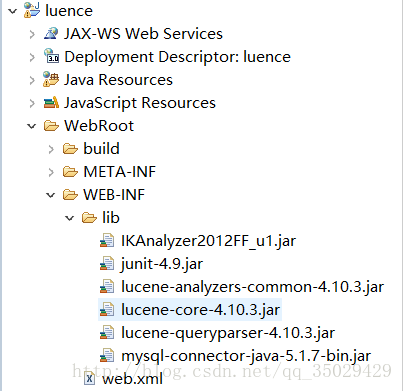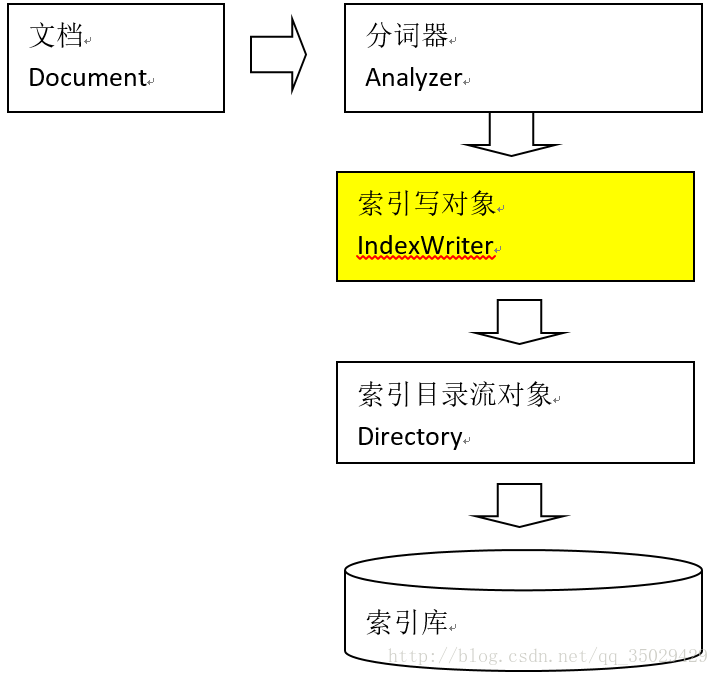【Lucene】全文检索技术详解
1.什么是lucene
Lucene是Apache的一个全文检索引擎(核心组件)工具包(jar包、类库),通过lucene可以让程序员快速开发一个全文检索功能。它不能独立运行,不能单独对外提供服务。
2.全文检索的定义
全文检索首先对要搜索的文档进行分词,然后形成索引,通过查询索引来查询文档。比如:字典,字典的偏旁部首页,就类似于luence的索引;字典的具体内容,就类似于luence的文档内容。
3.Lucene实现全文检索的流程

全文检索的流程:索引流程、搜索流程
索引流程:采集数据—》文档处理存储到索引库中
搜索流程:输入查询条件—》通过lucene的查询器查询索引—》从索引库中取出结—》视图渲染(Lucene本身不能进行视图渲染)。
4.入门程序
4.1 需求
使用lucene完成对数据库中图书信息的索引和搜索功能。
4.2 环境准备
Jdk:1.7及以上
Lucene:4.10(从4.8版本以后,必须使用jdk1.7及以上)
Ide:indigo
数据库:mysql 5
4.3 数据库脚本初始化
百度网盘链接:https://pan.baidu.com/s/1nuFeiwh 密码:alzy
4.4 Lucene下载
Lucene是开发全文检索功能的工具包,使用时从官方网站下载,并解压。
下载地址:http://archive.apache.org/dist/lucene/java/
4.5 工程搭建4.6 索引流程
1)采集数据的方式
对于互联网中的数据,使用爬虫工具(http工具)将网页爬取到本地
对于数据库中的数据,使用jdbc程序进行数据采集
对于文件系统的数据,使用io流采集
2)索引文件的逻辑结构文档域:文档域存储的信息就是采集到的信息,通过Document对象来存储,具体说是通过Document对象中field域来存储数据。比如:数据库中一条记录会存储一个一个Document对象,数据库中一列会存储成Document中一个field域。文档域中,Document对象之间是没有关系的。而且每个Document中的field域也不一定一样。
索引域:索引域主要是为了搜索使用的。索引域内容是经过lucene分词之后存储的。
倒排索引表:根据内容(词语)找文档,倒排索引结构也叫反向索引结构,包括索引和文档两部分,索引即词汇表,它是在索引中匹配搜索关键字,由于索引内容量有限并且采用固定优化算法搜索速度很快,找到了索引中的词汇,词汇与文档关联,从而最终找到了文档。3)索引
采集数据:
public class Book {
private Integer id; //图书ID
private String name; //图书名称
private Float price; //图书价钱
private String pic; //图书图片
private String description; //图书描述
//生成getXX()和setXX().....
}
public interface IBookDao {
List queryBooks();
}
public class IBookDaoImpl implements IBookDao {
@Override
public List queryBooks() {
//数据库连接
Connection conn = null;
//预编译statement
PreparedStatement ps = null;
//结果集
ResultSet resultSet = null;
//图书列表
List bookList = new ArrayList<>();
//加载数据库驱动
try {
Class.forName("com.mysql.jdbc.Driver");
//连接数据库
conn =DriverManager.getConnection("jdbc:mysql://localhost:3306/luence", "java", "123456");
//SQL语句
String sql = "SELECT * FROM Book";
//创建PreparedStatement
ps = conn.prepareStatement(sql);
//获取结果集
resultSet = ps.executeQuery();
//解析结果集
while(resultSet.next()){
Book book = new Book();
book.setId(resultSet.getInt(1));
book.setName(resultSet.getString(2));
book.setPrice(resultSet.getFloat(3));
book.setPic(resultSet.getString(4));
book.setDescription(resultSet.getString(5));
bookList.add(book);
}
} catch (Exception e) {
e.printStackTrace();
}
return bookList;
}
}
4)创建索引
创建索引流程: IndexWriter是索引过程的核心组件,通过IndexWriter可以创建新索引、更新索引、删除索引操作。IndexWriter需要通过Directory对索引进行存储操作。
Directory描述了索引的存储位置,底层封装了I/O操作,负责对索引进行存储。它是一个抽象类,它的子类常用的包括FSDirectory(在文件系统存储索引)、RAMDirectory(在内存存储索引)。
/**
* 添加索引
* @throws Exception
*/
@Test
public void createIndex() throws Exception {
//采集数据
IBookDao dao = new IBookDaoImpl();
List list = dao.queryBooks();
//将采集到的数据封装到Document对象中
List docList = new ArrayList<>();
Document document = null;
for (Book book : list) {
document = new Document();
//store:如果是yes,则说明存储到文档域中
//不分词、索引、存储StringField
Field id = new StringField("id", book.getId().toString(), Store.YES);
//分词、索引、存储TextField
Field name = new TextField("name", book.getName(), Store.YES);
//分词、索引、存储但是是数字类型,所有使用FloatField
Field price = new FloatField("price", book.getPrice(), Store.YES);
//不分词、不索引、存储StoredField
Field pic = new StoredField("pic", book.getPic());
//分词、索引、不存储TextField
Field description = new TextField("description", book.getDescription(), Store.NO);
//创建索引时设置boost值
if(book.getId() == 1){
description.setBoost(100f);
}
//将field域设置到Document对象中
document.add(id);
document.add(name);
document.add(price);
document.add(pic);
document.add(description);
docList.add(document);
}
//创建分词器,标准分词器
Analyzer analyzer = new StandardAnalyzer();
//创建IndexWriter
IndexWriterConfig indexWriterConfig = new IndexWriterConfig(Version.LUCENE_4_10_3, analyzer);
//指定索引库的地址
Directory directory = FSDirectory.open(new File("G:\\JAVA JELLO\\IndexFile"));
IndexWriter indexWriter = new IndexWriter(directory, indexWriterConfig);
//通过IndexWriter对象将Document写入到索引库中
for (Document doc : docList) {
indexWriter.addDocument(doc);
}
indexWriter.close();
}
分词:
Lucene中分词主要分为两个步骤:分词、过滤。
分词:将field域中的内容一个个的分词。
过滤:将分好的词进行过滤,比如去掉标点符号、大写转小写、词的型还原(复数转单数、过去式转成现在式)、停用词过滤
停用词:单独应用没有特殊意义的词。比如的、啊、等,英文中的this is a the等等。
语汇单元的生成过程: 从一个Reader字符流开始,创建一个基于Reader的Tokenizer分词器,经过三个TokenFilter生成语汇单元Token。
同一个域中相同的语汇单元(Token)对应同一个Term(词),它记录了语汇单元的内容及所在域的域名等,还包括来该token出现的频率及位置。
不同的域中拆分出来的相同的单词对应不同的term。
相同的域中拆分出来的相同的单词对应相同的term。
5)使用luke工具查看索引6)搜索流程
输入查询语句,同数据库的sql一样,lucene全文检索也有固定的语法:
最基本的有比如:AND, OR, NOT 等
举个例子,用户想找一个description中包括java关键字和lucene关键字的文档。
它对应的查询语句:description:java AND lucene
如下是使用luke搜索的例子: public void doSerach(Query query) throws Exception{
Directory directory = FSDirectory.open(new File("G:\\JAVA JELLO\\IndexFile"));
IndexReader reader = DirectoryReader.open(directory);
IndexSearcher searcher = new IndexSearcher(reader);
// 通过searcher来搜索索引库
// 第二个参数:指定需要显示的顶部记录的N条
TopDocs topDocs = searcher.search(query, 10);
// 根据查询条件匹配出的记录总数
int count = topDocs.totalHits;
System.out.println("匹配出的记录总数:" + count);
// 根据查询条件匹配出的记录
ScoreDoc[] scoreDocs = topDocs.scoreDocs;
for (ScoreDoc scoreDoc : scoreDocs) {
// 获取文档的ID
int docID = scoreDoc.doc;
// 通过ID获取文档
Document doc = searcher.doc(docID);
System.out.println("商品ID:" + doc.get("id"));
System.out.println("商品名称:" + doc.get("name"));
System.out.println("商品价格:" + doc.get("price"));
System.out.println("商品图片地址:" + doc.get("pic"));
System.out.println("==========================");
// System.out.println("商品描述:" + doc.get("description"));
}
reader.close();
}
/**
* 通过QueryParser创建查询对象
* @throws Exception
*/
@Test
public void indexSearch() throws Exception{
// 创建query对象
// 使用QueryParser搜索时,需要指定分词器,搜索时的分词器要和索引时的分词器一致
// 第一个参数:默认搜索的域的名称
QueryParser queryParser = new QueryParser("description", new StandardAnalyzer());
// 通过queryparser来创建query对象
// 参数:输入的lucene的查询语句(关键字一定要大写)
Query query = queryParser.parse("name:java OR description:luence");
// 创建IndexSearcher
// 指定索引库的地址
doSerach(query);
}5.Field域
5.1 Field的属性
是否分词(Tokenized)
是:对该field存储的内容进行分词,分词的目的,就是为了索引。
比如:商品名称、商品描述、商品价格
否:不需要对field存储的内容进行分词,不分词,不代表不索引,而是将整个内容进行索引。
比如:商品id
是否索引(Indexed)
是:将分好的词进行索引,索引的目的,就是为了搜索。
比如:商品名称、商品描述、商品价格、商品id
否:不索引,也就是不对该field域进行搜索。
是否存储(Stored)
是:将field域中的内容存储到文档域中。存储的目的,就是为了搜索页面显示取值用的。
比如:商品名称、商品价格、商品id、商品图片地址
否:不将field域中的内容存储到文档域中。不存储,则搜索页面中没法获取该field域的值。
比如:商品描述,由于商品描述在搜索页面中不需要显示,再加上商品描述的内容比较多,所以就不需要进行存储。
如果需要商品描述,则根据搜索出的商品ID去数据库中查询,然后显示出商品描述信息即可。
5.2 Field的常用类型
下边列出了开发中常用 的Filed类型,注意Field的属性,根据需求选择:6.索引维护
1)删除索引
根据条件删除:Term是索引域中最小的单位。根据条件删除时,建议根据唯一键来进行删除。在solr中就是根据ID来进行删除和修改操作的。
/**
* 删除索引
* @throws IOException
*/
@Test
public void deleteIndex() throws IOException{
//创建标准分词器
Analyzer analyzer = new StandardAnalyzer();
//创建IndexWriter
IndexWriterConfig cfg = new IndexWriterConfig(Version.LUCENE_4_10_3, analyzer);
Directory directory = FSDirectory.open(new File("G:\\JAVA JELLO\\IndexFile"));
IndexWriter indexWriter = new IndexWriter(directory, cfg);
//Terms
indexWriter.deleteDocuments(new Term("id","1"));
//indexWriter.deleteAll();
indexWriter.close();
}
2)修改索引
/**
* 修改索引
* @throws Exception
*/
@Test
public void updateIndex() throws Exception{
Analyzer analyzer = new StandardAnalyzer();
IndexWriterConfig cfg = new IndexWriterConfig(Version.LUCENE_4_10_3, analyzer);
Directory directory = FSDirectory.open(new File("G:\\JAVA JELLO\\IndexFile"));
IndexWriter indexWriter = new IndexWriter(directory, cfg);
//修改时如果根据查询条件,可以查询出结果,则将以前的删除掉,然后覆盖新的Document对象,如果没有查询出结果,则新增一个Document
//修改流程:先查询、再删除、再添加
Document doc = new Document();
doc.add(new TextField("name", "lisi", Store.YES));
indexWriter.updateDocument(new Term("name", "zhangsan"), doc);//第一个参数:指定查询条件 第二个参数:修改之后对象
indexWriter.close();
}7.搜索
1)创建查询对象的方式
##通过Query子类来创建查询对象
Query子类常用的有:TermQuery、NumericRangeQuery、BooleanQuery,不能输入lucene的查询语法,不需要指定分词器。
##通过QueryParser来创建查询对象(常用)
QueryParser、MultiFieldQueryParser,可以输入lucene的查询语法、可以指定分词器。
##通过Query子类来创建查询对象
/**
* 1.TermQuery:精确的词项查询
* @throws Exception
*/
@Test
public void termQuery() throws Exception{
Query query = new TermQuery(new Term("description", "java"));
doSerach(query);
}
/**
* 2.NumericRangeQuery:数字范围查询
* @throws Exception
*/
@Test
public void numericRangeQuery() throws Exception{
//创建NumericRangeQuery对象
//参数:域的名称,最小值,最大值,是否包含最小值,是否包含最大值
Query query = NumericRangeQuery.newFloatRange("price", 55f, 60f, true, true);
doSerach(query);
}
/**
* 3.组合查询BooleanQuery
* @throws Exception
*/
@Test
public void booleanQuery() throws Exception{
BooleanQuery query = new BooleanQuery();
TermQuery q1 = new TermQuery(new Term("description", "luence"));
Query q2 = NumericRangeQuery.newFloatRange("price", 55f, 60f, true, true);
/**
1、MUST和MUST表示“与”的关系,即“并集”。
2、MUST和MUST_NOT前者包含后者不包含。
3、MUST_NOT和MUST_NOT没意义
4、SHOULD与MUST表示MUST,SHOULD失去意义;
5、SHOUlD与MUST_NOT相当于MUST与MUST_NOT。
6、SHOULD与SHOULD表示“或”的概念。
*/
query.add(q1, Occur.SHOULD);
query.add(q2, Occur.SHOULD);
doSerach(query);
}
##通过QueryParser创建查询对象
/**
* MultiFieldQueryParser:多域查询
* @throws Exception
*/
@Test
public void multiFieldQueryParser() throws Exception{
String[] fields = {"name","description"};
// Analyzer analyzer = new StandardAnalyzer();
//使用ikAnalyzer分词器
IKAnalyzer analyzer = new IKAnalyzer();
//在MultiFieldQueryParser创建时设置boost值。
Map boosts = new HashMap();
boosts.put("name", 200f);
MultiFieldQueryParser multiFieldQueryParser = new MultiFieldQueryParser(fields, analyzer,boosts );
Query query = multiFieldQueryParser.parse("java");//等同于 multiFieldQueryParser.parse("name:luence OR description:luence");
System.out.println("查询语句:"+query);
doSerach(query);
}
2)查询语法
1、基础的查询语法,关键词查询:
域名+“:”+搜索的关键字
例如:content:java
2、范围查询
域名+“:”+[最小值 TO 最大值]
例如:size:[1 TO 1000]
注意:QueryParser不支持对数字范围的搜索,它支持字符串范围。数字范围搜索建议使用NumericRangeQuery。
3、组合条件查询
Occur.MUST 查询条件必须满足,相当于and +(加号)
Occur.SHOULD 查询条件可选,相当于or 空(不用符号)
Occur.MUST_NOT 查询条件不能满足,相当于not非 -(减号)
1)+条件1 +条件2:两个条件之间是并且的关系and
例如:+filename:apache +content:apache
2)+条件1 条件2:必须满足第一个条件,忽略第二个条件
例如:+filename:apache content:apache
3)条件1 条件2:两个条件满足其一即可。
例如:filename:apache content:apache
4)-条件1 条件2:必须不满足条件1,要满足条件2
例如:-filename:apache content:apache
第二种写法:
条件1 AND 条件2
条件1 OR 条件2
条件1 NOT 条件2
3)TopDocs
Lucene搜索结果可通过TopDocs遍历,TopDocs类提供了少量的属性,如下:
方法或属性 说明
totalHits 匹配搜索条件的总记录数
scoreDocs 顶部匹配记录
注意:
Search方法需要指定匹配记录数量n:indexSearcher.search(query, n)
TopDocs.totalHits:是匹配索引库中所有记录的数量
TopDocs.scoreDocs:匹配相关度高的前边记录数组,scoreDocs的长度小于等于search方法指定的参数n 8.中文分词器
1)什么是中文分词器
对于英文,是安装空格、标点符号进行分词
对于中文,应该安装具体的词来分,中文分词就是将词,切分成一个个有意义的词。
2)Lucene自带的中文分词器
StandardAnalyzer单字分词:就是按照中文一个字一个字地进行分词。如:“我爱中国”,
效果:“我”、“爱”、“中”、“国”。
CJKAnalyzer二分法分词:按两个字进行切分。如:“我是中国人”,效果:“我是”、“是中”、“中国”“国人”。
上边两个分词器无法满足需求。
3)第三方中文分词器IK-analyzer4)代码
//使用ikAnalyzer分词器
IKAnalyzer analyzer = new IKAnalyzer();
5)扩展中文词库
将以下文件拷贝到config目录下IKAnalyzer.cfg.xml内容如下:
<properties>
<comment>IK Analyzer 扩展配置comment>
<entry key="ext_dict">ext.dic;entry>
<entry key="ext_stopwords">stopword.dic;entry>
properties>










